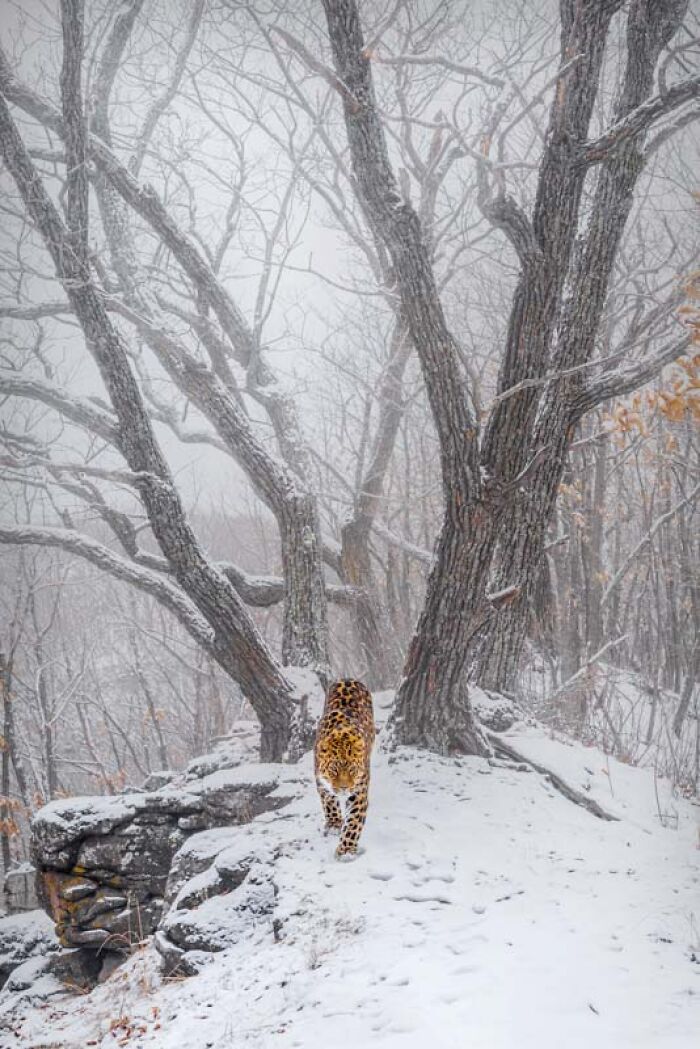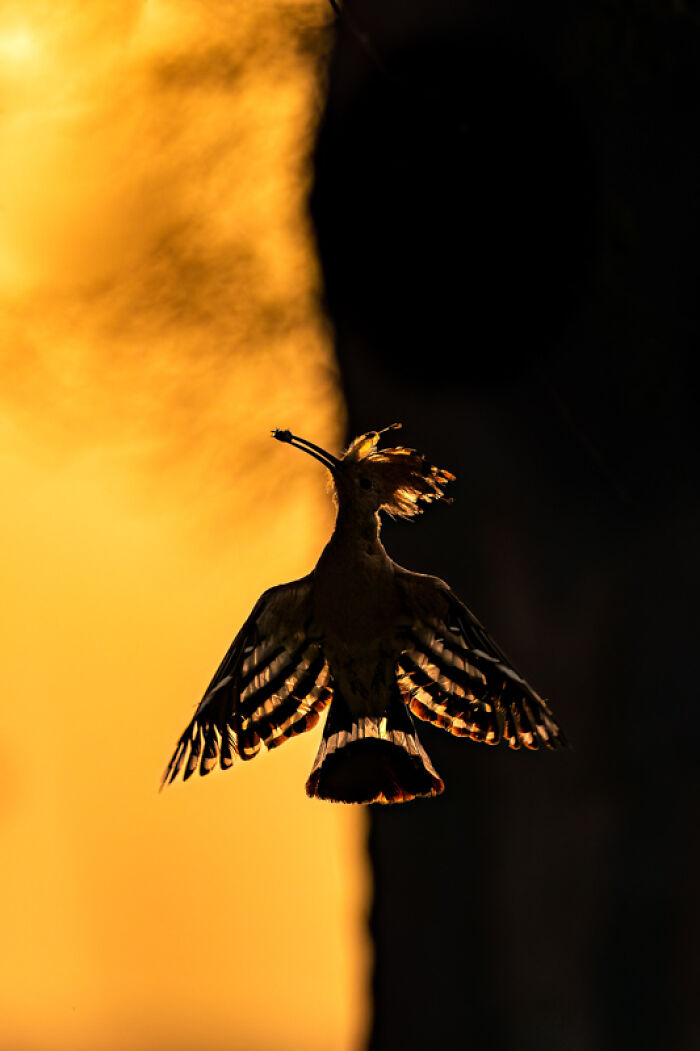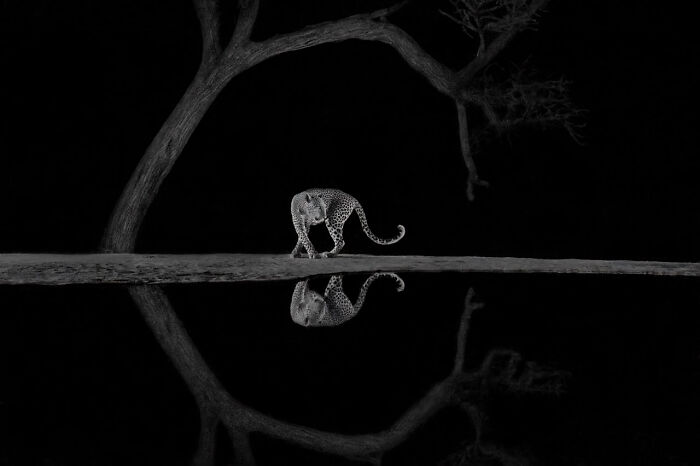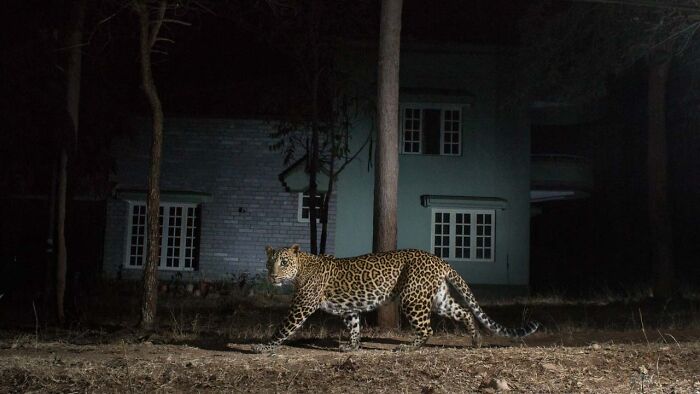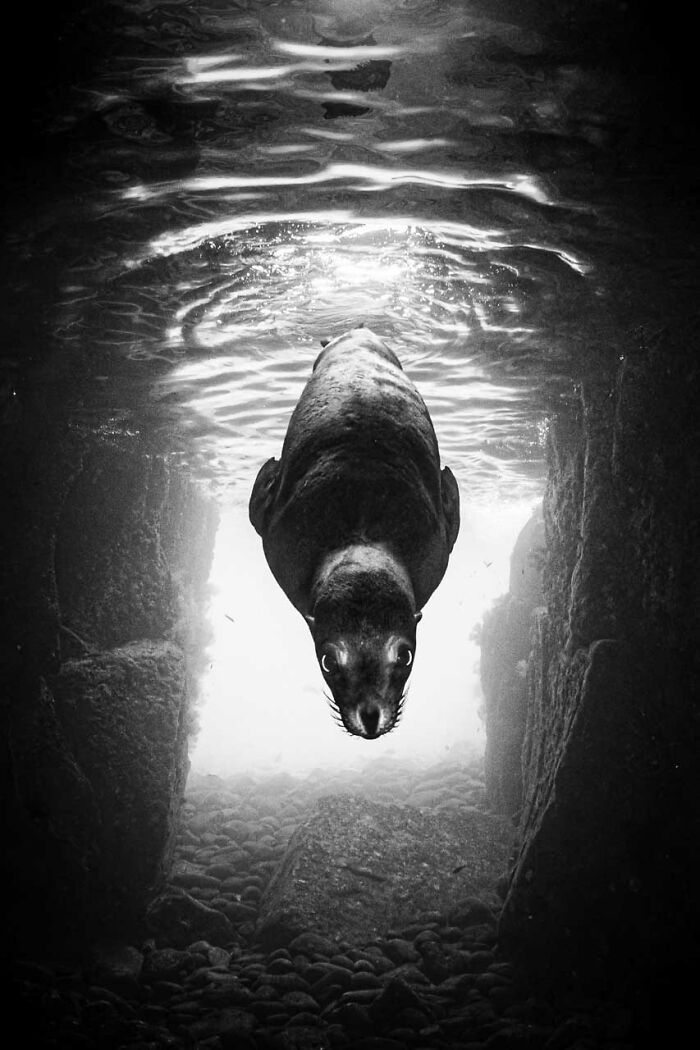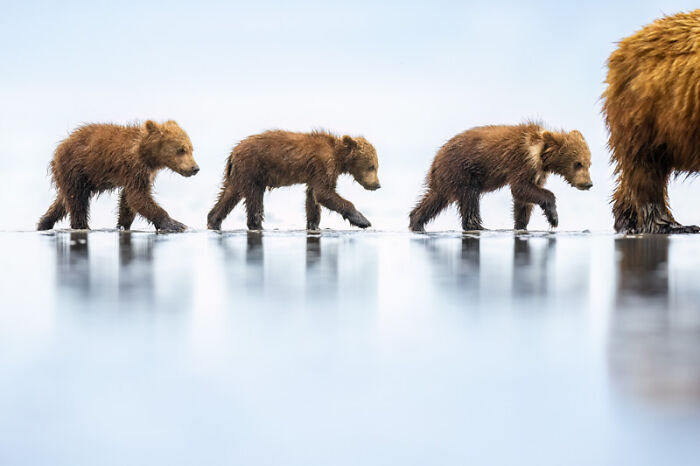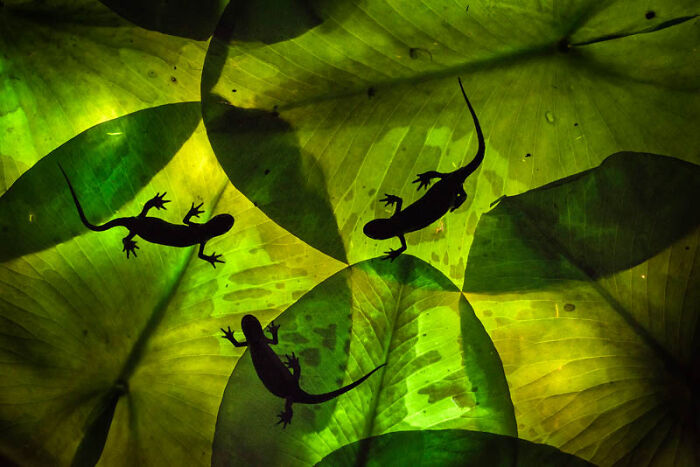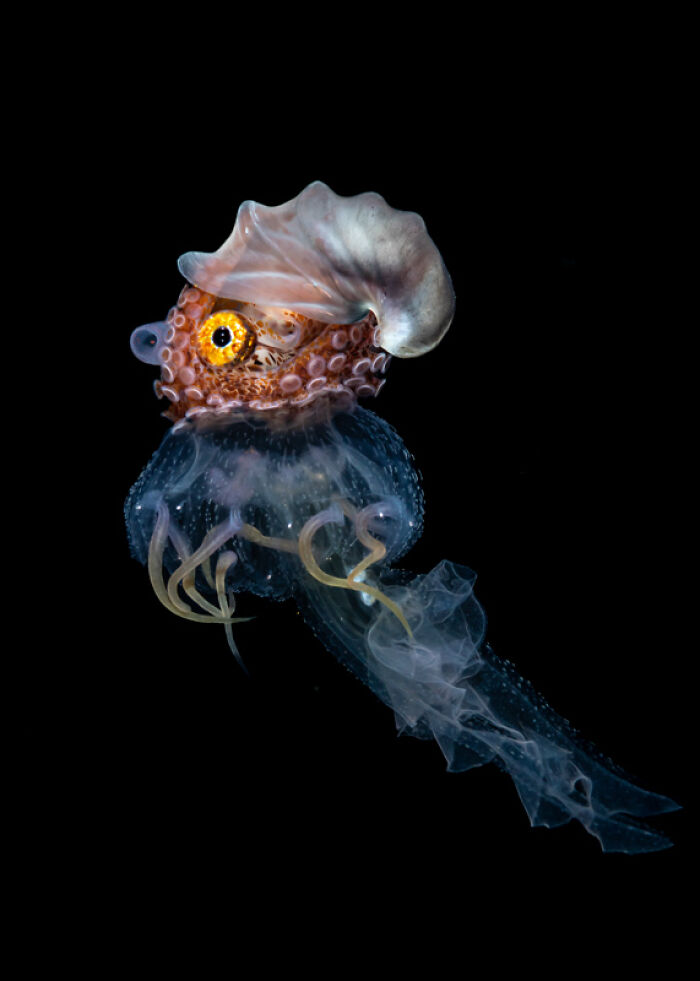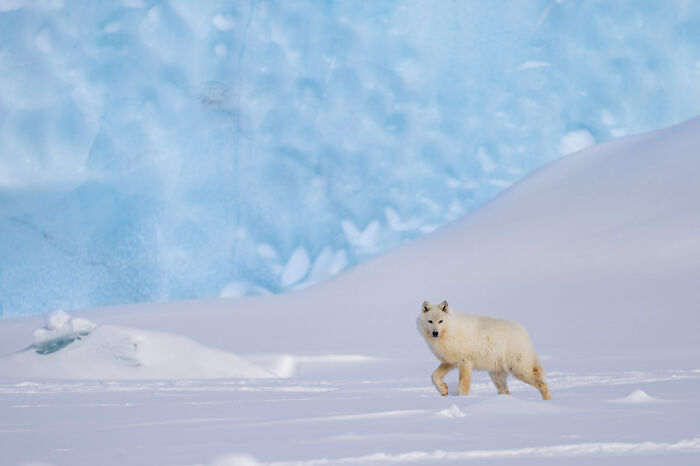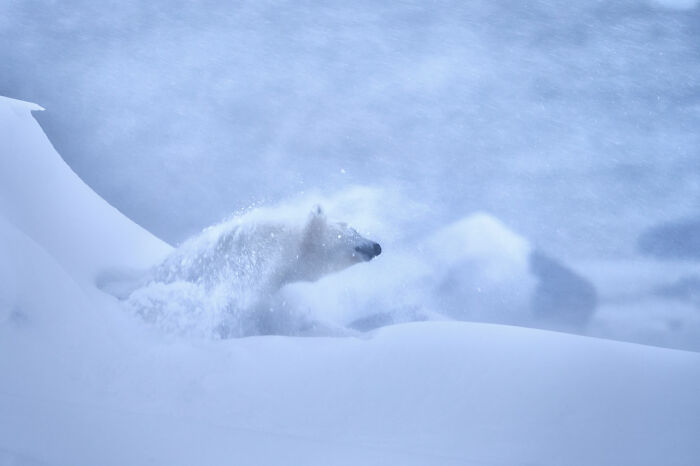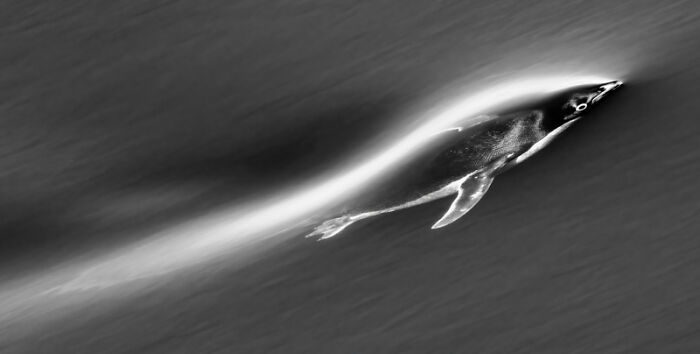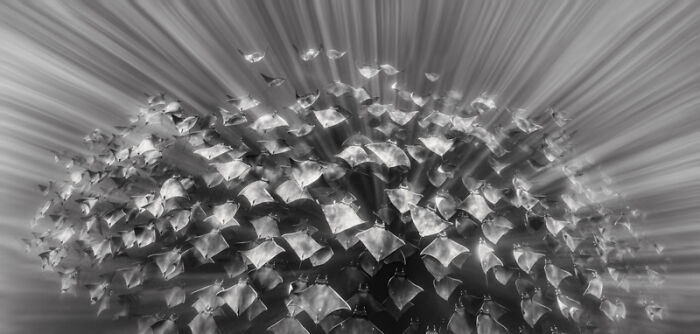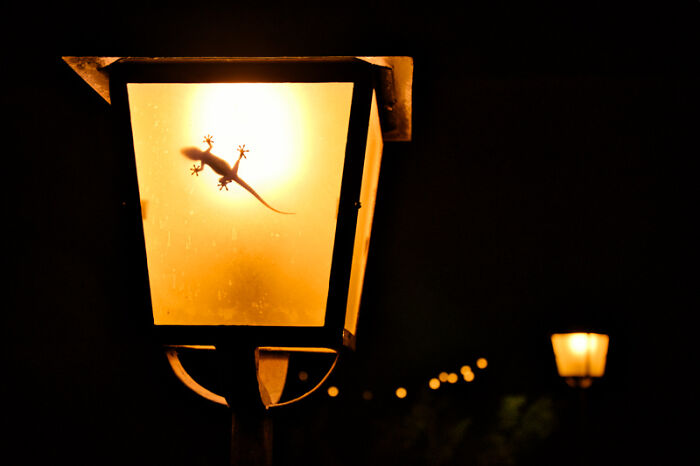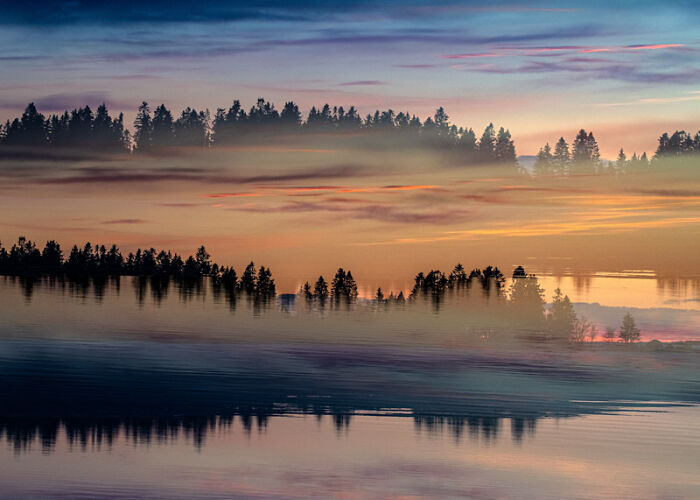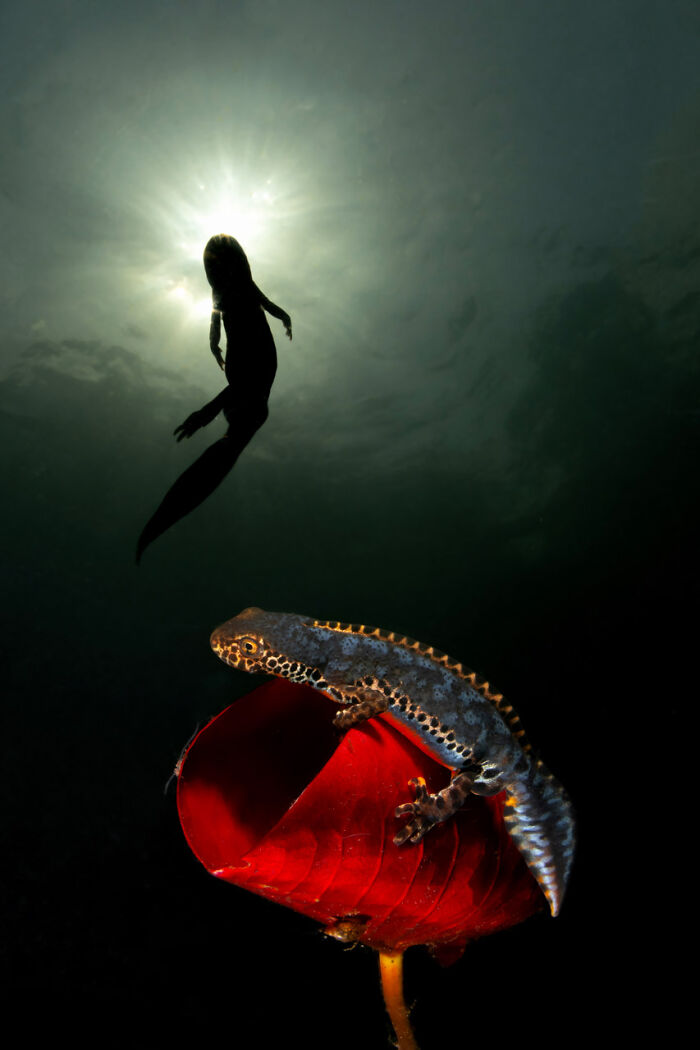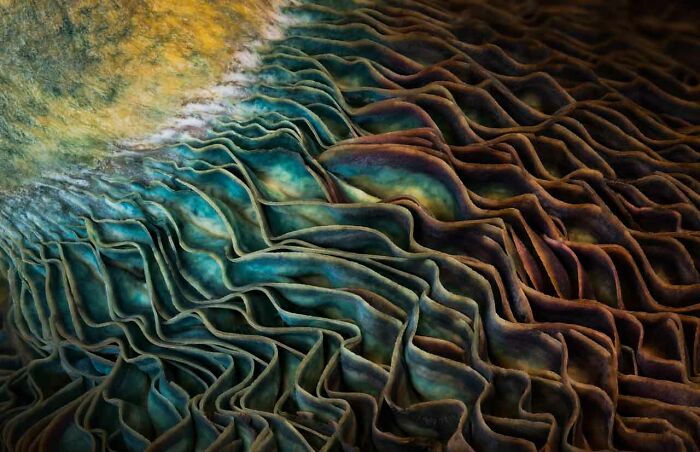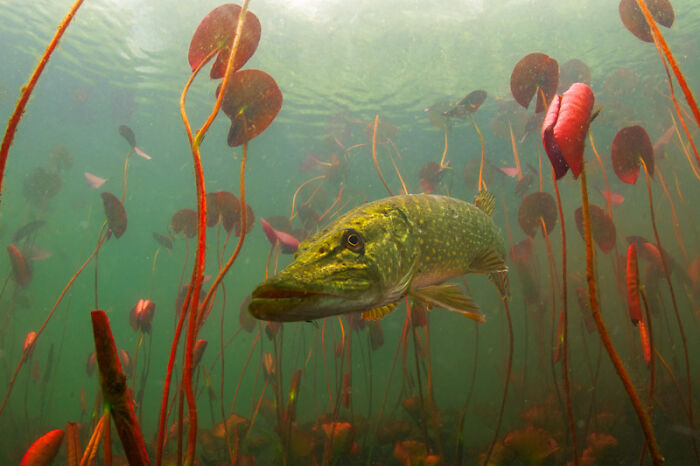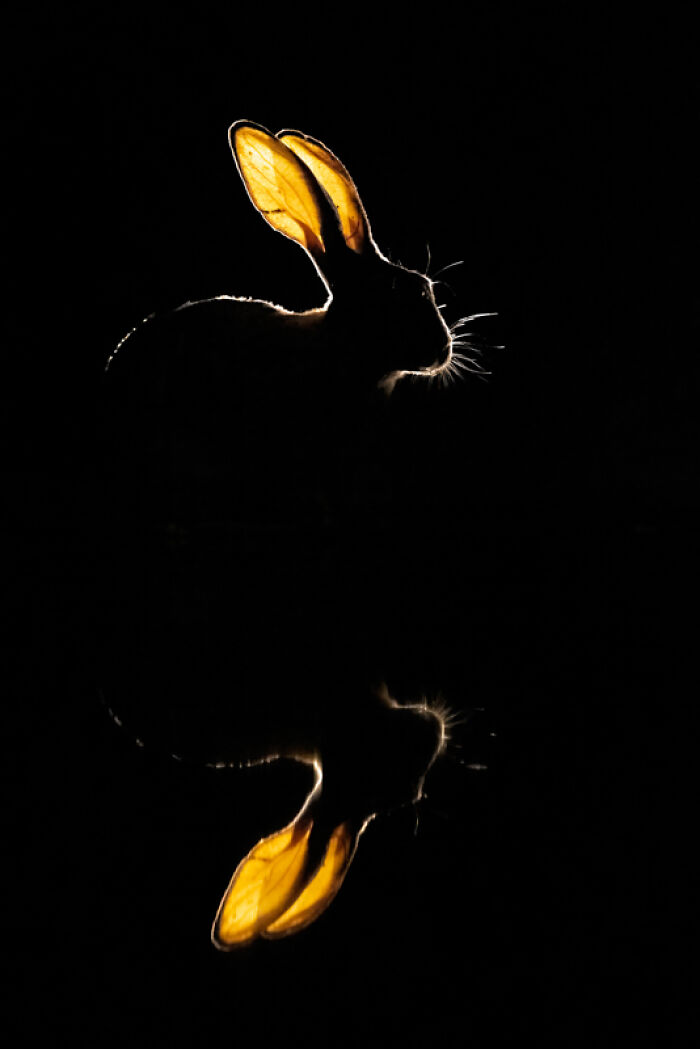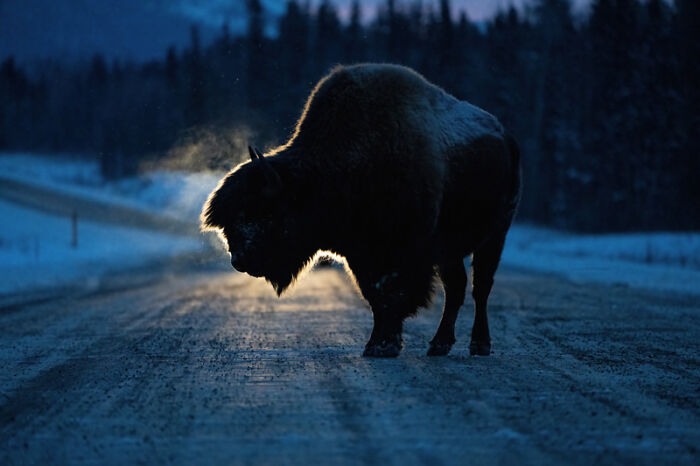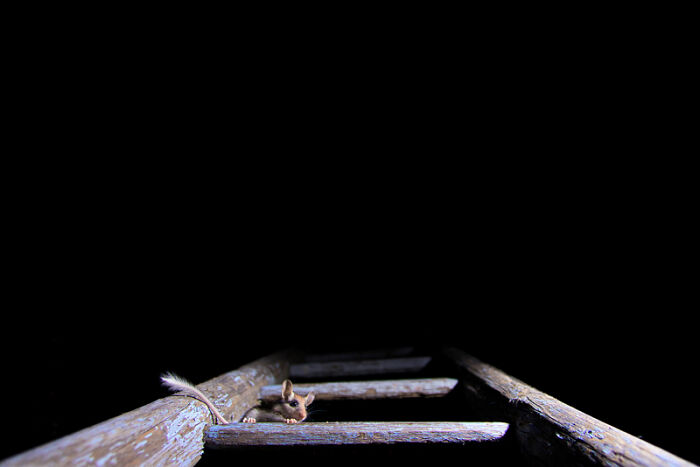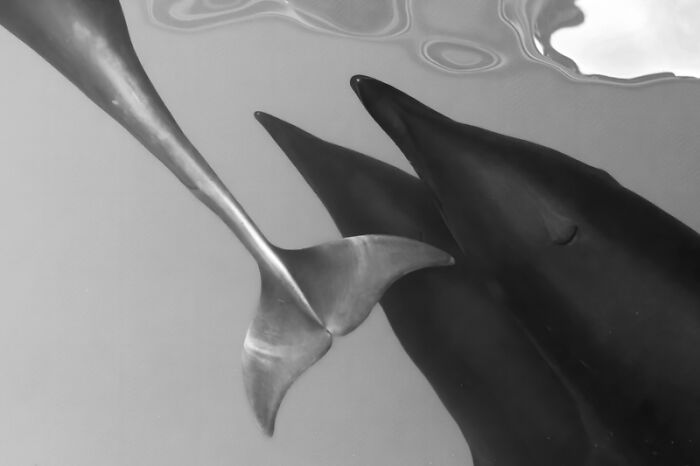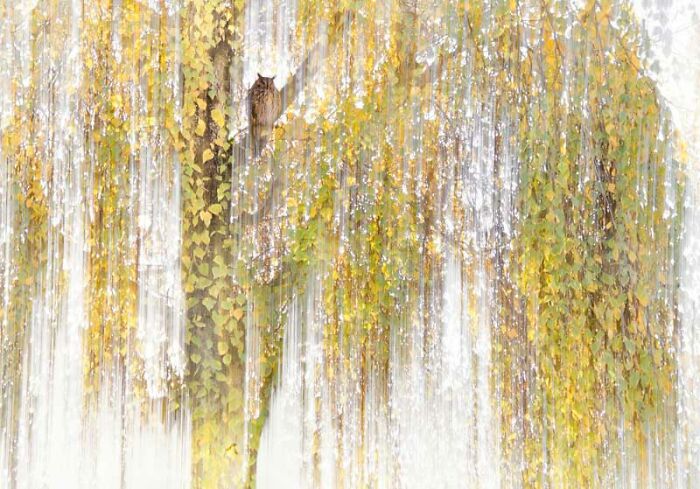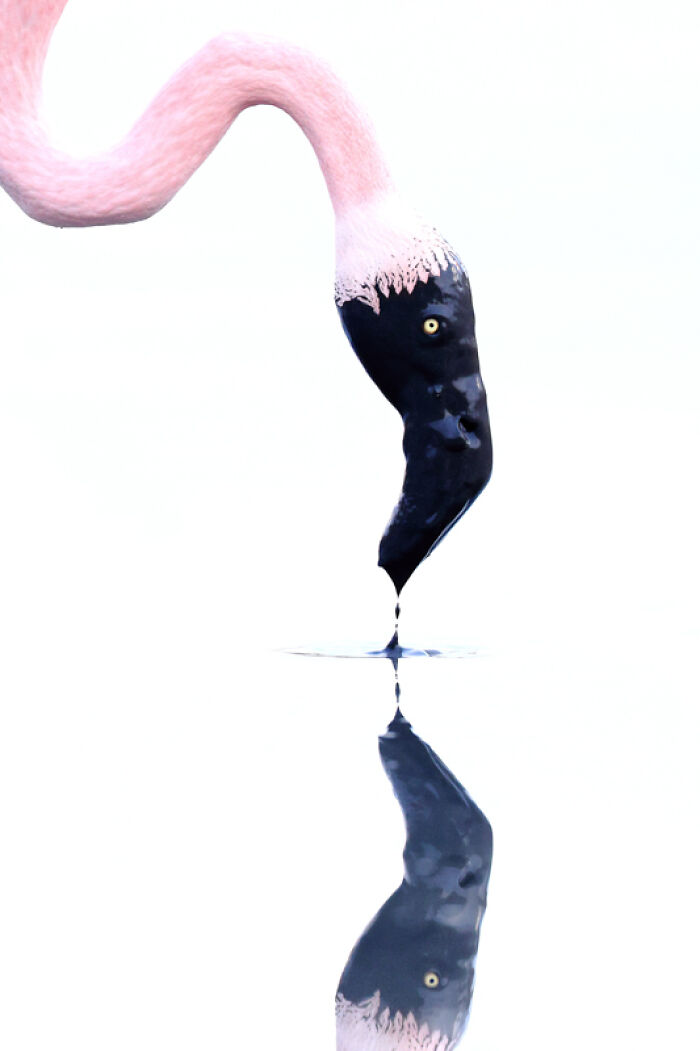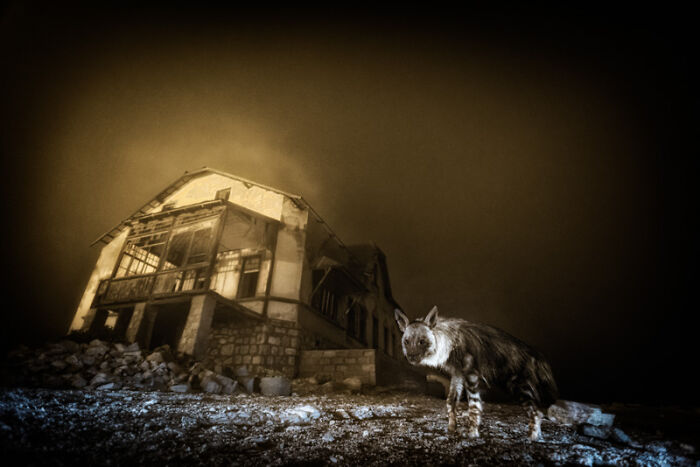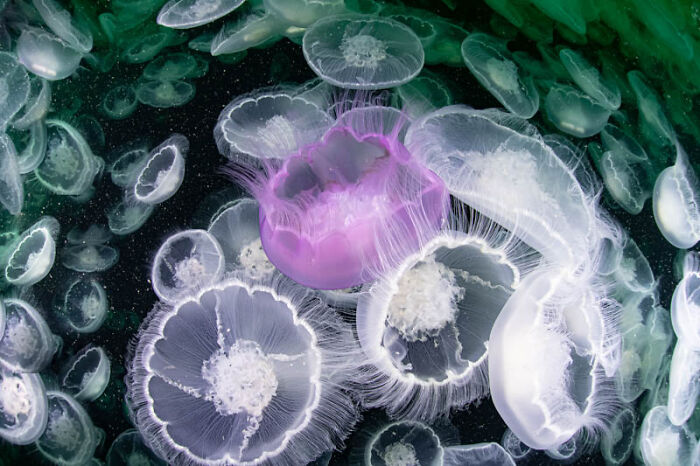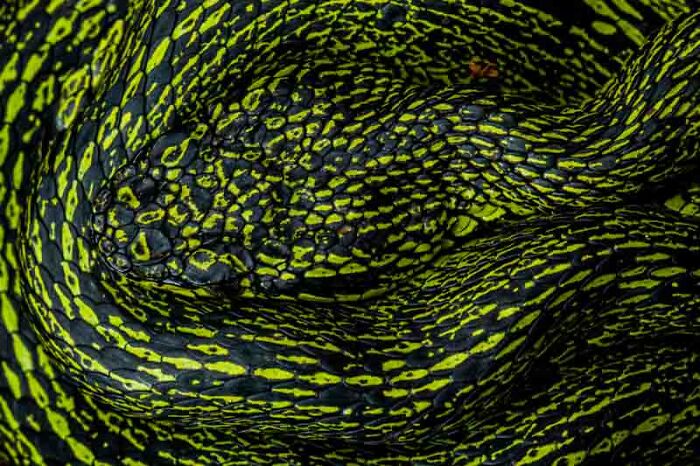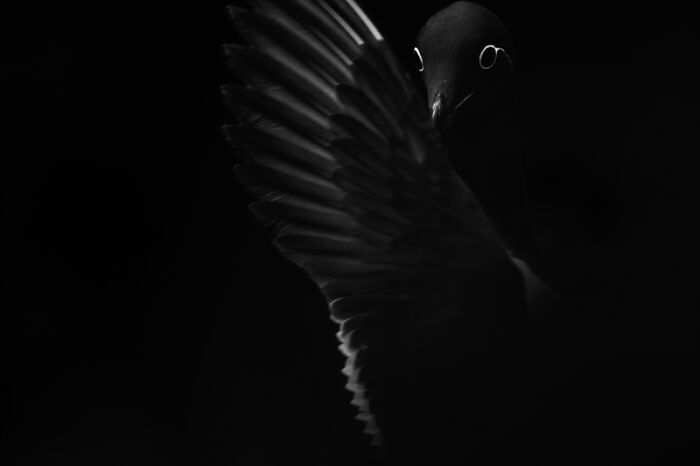Category Mammals: Highly Commended, “Amur Leopard” By Sergey Gorshkov
“Amur leopard. The photo was taken in the national park ‘Land of the Leopard’ for a photo project. I like to photograph a leopard in the snow.”
Overall Winner: “He Looks To The Heavens” By Jacquie Matechuk, Canada
“Spanning more than 8,000km, the Andean Mountain range occupies more than a quarter of the land surface in Ecuador. Rich in biodiversity, it’s also home to a unique species called the Spectacled bear. Until planning this trip, I knew nothing of them. But as a certified bear guide, I was excited to expand my knowledge and understanding of a new species and to compare behavior and their interactions to those of our grizzly, polar, black, and brown bears.
As we drove from Quito to the Andean mountains, through villages and farming communities, the extraordinary conditions and fertility of this land were inescapable. Hours of winding roads and stunning landscapes later, we pulled into a small community where we were greeted by a local farmer/guide. A gentle-natured man who’s worked tirelessly for decades to observe, learn, and advocate for this endangered species. His family’s hospitality reaching far beyond opening his home, opened a door to a whole new world.
For 11 days at roughly 8,000 feet above sea level, we hiked vertical paths up and down the canyon walls, trekking through creeks, ducking out of torrential downpours, and often clambering through mud to observe these beautiful bears. In their natural habitat and with our guide’s intimate knowledge of each bear, we were quickly accepted by them. We kept a respectful distance to ensure their comfort and it paid off in spades. They would nurse, fall asleep, cuddle, forage, and play, seemingly more oblivious to our presence with each passing encounter.
In this image, Tony (a large male spectacled bear), and frequent traveler through these parts had climbed into a century-old fig tree seeking refuge from the midday sun. It was draped in Spanish moss, gently swaying with each breath inhaled and exhaled by the canyon walls. He sauntered effortlessly across a burly branch and sat peacefully against the tree’s trunk. When a gentle rain began to fall across the valley, he stood and turned to look up as though embracing the cool moisture on his speckled face. And for a fleeting moment, the warmth of muted sunlight falls across his face as ‘He Looks to the Heavens’.”
Category Birds: Winner, “Dawn’s Whispers: Graceful Hoopoe Silhouette At Sunrise” By Hermis Valiyandiyil, United Arab Emirates
“This picture of Hoopoe was taken in Dubai from Al Qudra Lakes. I spend most of my weekends taking pictures of the birds in Al Qudra Lakes. I wanted to test my new Nikon Z8 camera. So, my friend and I traveled to the lake where I noticed a Hoopoe occasionally catching its prey in the air and at other times on the ground. Additionally, I observed that each time it caught prey, it flew in the same direction to a nearby tree. I spent a few days photographing this bird, and when I got home and looked over the pictures, I got the idea to photograph the bird against a background with light and dark sides to represent the dark and light sides of existence. The following day, I arrived a little earlier at the same location and waited for the ideal shot to occur.”
#4
Category Black And White: Highly Commended, “Graceful Turn” By Richard Li, USA
“Capturing the Majesty of a Kenyan Night. Lentorre, nestled alongside the Maasai Mara grasslands in Kenya, is a highland region known for its breathtaking natural beauty. However, in recent years, it has been experiencing the harsh impacts of the monsoon and the effects of global climate change, resulting in prolonged periods of scorching, arid weather. Last October, I found myself back in this remarkable place, taking shelter beside a small waterhole, poised to capture the enchanting nocturnal moments of wild animals quenching their thirst. During the first half of the night, the waterhole attracted a diverse array of creatures – antelopes, zebras, giraffes, porcupines, and mongooses. Yet, as the latter half of the night approached, an eerie stillness fell over the water, signaling that something extraordinary was about to unfold. Indeed, it did. Emerging gracefully from the obscurity of the thicket, a colossal adult leopard made its grand entrance. As the apex predator, it displayed none of the timidness seen in herbivorous animals and seemed unfazed by the floodlights we had carefully positioned. Slowly and deliberately, it patrolled the water’s edge, casting a flawless reflection in the tranquil pool. When it reached a sinuous tree at the water’s edge, it executed a graceful pivot. At that moment, I pressed the shutter button, capturing the epitome of elegance in the Kenyan night.”
Category Human And Nature: Runner-Up, “No Land For Leopards” By Pruthvi B, India
“Leopards (Panthera pardus fusca) are some of the most elusive and adaptable big cats in India. Habitat loss due to rapid urbanization has pushed these big cats close to human habitation. Most of the time, farmlands and human settlements are used by these cats to hunt small mammals, poultry, other farm animals, and stray or free-roaming dogs. These majestic cats are listed as vulnerable on the ICUN Red list.
“No Land for Leopard” has been an ongoing project for 5 years as part of capturing urban wildlife through camera trapping in and around Mysore in south India. This image is part of the series. This camera trap image was the result of months of tracking and planning. Monitoring its movement, its frequency, and the regular path that it used was determined. Finally, a DSLR camera trap was placed. The biggest challenge was the weather; it was the start of monsoon season. The main idea for this frame was to show how close these cats move around human habitation without being noticed. It also shows the elusive nature of the leopard, redefines human-wildlife boundaries, and reiterates that ‘we humans live in a shared space’.”
Category Animals Portraits: Highly Commended, “The Look” By Henley Spiers, United Kingdom
“Life as an underwater wildlife photographer mostly involves trying to very gently accustom animals to our presence. As photography through water requires extreme proximity, we are usually unable to completely conceal ourselves from the wildlife and cannot rely on long lenses or hides to aid in fieldcraft.
Blissfully, the California sea lion pups at this marine protected area require no such strategies, as they actively seek out interaction…curiously checking out human visitors with playful enthusiasm. Placing myself at the end of this underwater cavern beneath a sea lion colony, I had to wait less than a minute before this pup came to investigate.
Location: Espiritu Santo National Park, Baja California Sur, Mexico.”
Category Mammals: Highly Commended, “Follow The Leader” By Torie Hilley, USA
“Mother coastal brown bears (Ursus arctos gyas) and cubs are constantly on the lookout for male bears that will kill the cubs to mate with the mother to pass on their own genes. To see a bear cub is special, but to see THREE with one mother is extra special. I had the privilege to encounter these three little ones in Lake Clark National Park and Preserve in Alaska, USA. While with a professional bear guide, I followed them with their mother on the mudflats as they dug for clams, hoping to catch them in a line. For several days, I trudged through the thick, sticky mud in hopes of this shot. On the last day, I saw the cubs start to line up. I dropped to one knee into the mud and hovered my massive lens over the mudflat to blur out the foreground, creating an other-worldly feel. Patience can pay off, and I was thrilled to capture this behavior, especially with all three in step with one another. Back home and ecstatic to have achieved my goal, I, unfortunately, heard that all three cubs didn’t survive the upcoming weeks. Heartbroken to hear this, it reminded me to never take anything for granted and to enjoy nature’s beauty as much as possible in that moment because you never know what happens next.”
Category Nature Of “De Lage Landen”: Runner-Up, “Green Triplets” By Johan De Ridder, Belgium
“Several years ago, during a hike in the Flemish region near Ghent, I found a human-made natural pond. This pond was abandoned for years, overgrown, and almost invisible to the eye, never removed by the original owner. When I arrived it was already late and getting dark. Being tired from my long walk I sat down and watched what was going on in this small fascinating world. Suddenly some lights in the pond were automatically activated. Who put on the lights? These lights were still there, forgotten below the surface, loaded by solar power cells hidden in the overgrown weeds. Suddenly, attracted by the lights, some alpen water salamanders (Ichthyosaura alpestris) appeared. At first one, then two, and then lots of them… what a surprise. This gave me an idea and I would be back with my gear, later that week. With only my trusty Nikon, macro lens, and swimming trunks, I went into the pool that was luckily only 50cm deep. Just enough to get my subjects in focus. I always had to wait until it was dark enough, so the lights went on. This took a lot of time, back pain, mosquito bites, and more than 300 shots, resulting in only 5 acceptable pictures. Each time I made a small move, all the animals disappeared for several minutes and I had to start all over again. And yet, they always came back. Out of curiosity and also because they are using the light to hunt for small insects, snails, or larvae. A few days later the pond was removed and a new house was built in this location… very sad for these small creatures. Always grasp the opportunity when it comes your way.”
Category Underwater: Winner, “Paper Nautilus Rider” By Renee Capozzola, USA
“This image of a paper nautilus with jellyfish was shot off Anilao in Balayan Bay, Batangas, Philippines with a 60mm lens during a Blackwater dive. During this type of dive, which is performed over very deep water at night, divers search for tiny critters with handheld torches while circling a lit downline. Towards the end of my dive at approximately 10-15 meters of depth, I spotted this paper nautilus or Argonaut, which is often seen riding on the back of a jellyfish. This paper nautilus is a female as it features a thinly secreted coiled shell or egg case which resembles a hat. These unique cephalopods rise towards the surface at night to feed and in this case, aerate their eggs.”
Category Mammals: Highly Commended, “Wolf And Iceberg” By Christophe Vasselin, Luxembourg
“The Arctic wolf (Canis lupus arctos) is for me the most elusive and iconic arctic animal. This wolf lives exclusively in the Canadian High Arctic. Meeting it requires a lot of organization, logistics, physical engagement, patience, luck, and a competent Inuit team. We were on Ellesmere Island, the northernmost point of land in Canada and one of the most northern points of land on the planet, looking for wildlife for 10 days when we met this wolf. We had set up our base camp near an iceberg trapped in the ice floe. In the morning, one of our guides told us that they had spotted a wolf eating a baby seal. Happily, the wolf decided to eat the prey very close to our camp, and without disturbing him during his meal, we observed it for 2 hours. Then, he decided to leave and passed just in front of the incredible blue iceberg. A perfect shot and an unforgettable moment.”
Category Mammals: Runner-Up, “Shaking Off The Cold” By Jeffrey Kauffman, USA
“One of the reasons I am so happy this photo won is because the story behind it is very interesting. One of my lifelong dreams was to see polar bears in the wild. Last year I set out for Churchill, Manitoba in Canada to photograph polar bears for the first time. I had a very productive trip, taking thousands of photos of polar bears and foxes. I was very happy with the whole trip. When it came time to leave Churchill, there was a slight problem. A massive blizzard had fallen on Churchill with 30-50 mph winds and freezing temperatures. All flights were canceled that day. Everyone was worrying about what to do, how to get home, connecting flights, etc… Our guides quickly told us to get in the vehicles because they spotted a bear along the Hudson Bay coast. All worries about missing the flight just vanished. Driving in blizzard conditions, we approached the polar bear sitting in the snow in front of a sand dune covered with snow. We all got out of the vehicles and started taking photos. The wind was so strong it was impossible to handhold or even use the tripod without having the camera shake! I ended up using the rearview mirror and the body of the truck we were in to keep the camera steady as I pressed myself and the camera against the truck body as hard as I could. I noticed every 10 -15 minutes the bear would rise out of the snow and shake off. I tried different shutter speeds to get the right feel for the photo. I found that a very low shutter speed blurred the fast-moving snow and made the background more uniform.”
Category Black And White: Highly Commended, “Swimming Underwater” By Risto Raunio, Finland
“I am keen on penguins, and my dream is to have pictures of all (17-18) penguin species in the world. On January 2023 I was on the journey heading to Antarctica. We started our trip from New Zealand and on the way heading to the Ross Sea, I was lucky to see six different penguin species on a few islands of the Subantarctic area.
Sailing carefully through drift ice in the middle of Ross Sea, I noticed that a few Adelie penguins were swimming in the sea behind and on both sides of our ship. They either swam in the water or run on the ice floes, which was funny, but also amazing to see. The left side of the ship was luckily in shadow where it was possible to see underwater without a polarized filter. On the deck of our ship, I followed a penguin that swam occasionally just a little bit underwater. This wonderful show lasted only two or three minutes, but I was lucky to have many pictures of this lovely bird and of this rare photo situation. Converting this picture from the original RAW to jpg format I was sure the black and white version looked much better than the same picture in colors.”
Category Black And White: Highly Commended, “Mobula Ray Fever” By Martin Broen, USA
“Every year there’s an aggregation of mobula rays in Baja California, Mexico. An amazing moving fever of rays that create an immense dynamic pattern of light reflections underwater. You don’t get to distinguish the individuals but a single mass. For a week been trying different techniques underwater, half and half, as well as top side as mobula jumps quite high out of the water as part of their social ritual.
During the morning, the sun was penetrating the water at an angle that allowed for a show of fluctuating light rays that somehow complemented the moving texture of the mobulas, and provided even more volume to the photo. After getting some good detail shots of a few individuals reaching toward the sun, I became obsessed with capturing a dramatic shot of the full group and showcasing its massive size, but after several attempts, I realized that at the proximity dictated by the water visibility, not even my fish-eye lens will fit all of them in a single frame. So fitted my rectilinear wide-angle lens in the underwater housing and attempted a x6 shot panorama, doing it fast enough that allow me to stitch that moving mass. And getting them framed by the morning rays.”
Category Youth: Highly Commended, “Lantern Gecko” By Anton Trexler, Germany
“The gecko sits in the lamp. Light attracts insects, which are the gecko’s food source. Even though light pollution kills countless insects every night, this image shows an interesting interplay in which animals benefit from our civilization through adaptation.”
Category Landscape: Runner-Up, “Sunset” By Jens Lax, Finland
“In the summer I live at my summer cottage by the sea in Oravais, Finland. I see beautiful sunsets almost every night. Yes, it is beautiful with sunsets in the sea. But there are usually hundreds of pictures of sunsets appearing on social media every night. So I thought I’d experiment with making a slightly different sunset image. I started by testing different double exposures but then I realized that if I turn the camera upside down in one of the images, I get a small effect of a reflection. And that’s how this picture came about.”
Category Black And White: Runner-Up, “The Charge” By David Gibbon, United Kingdom
“In March 2022, after three years of planning, I went to Ellesmere Island in the Canadian High Arctic. I and four others traveled across this extreme environment to find and photograph arctic wolves, musk ox, and other arctic wildlife. We experienced cold well below -50 degrees but came home with images of arctic hares and little else. In March 2023 I tried again. On this trip, not only did we find arctic wolves, but I also had this incredible experience with a herd of musk ox.
I lay flat on the ground, as the temperature dropped below -40, watching this herd charge but from quite a distance away. Knowing they could trample me to death, as some musk ox bulls can weigh up to 400kg each, it was a real test of nerve as they approached me at full speed. To make sure they did not know I was there, I continued to stay flat to the ground. In order to capture the image I removed my down gloves and was just wearing very a thin glove base layer. At this point, my hands were so cold I could not physically use my camera finger to press the shutter so I was forced to take the image with my middle finger. As they got closer, I quickly stood up and, thankfully, the herd changed direction and ran past me. It all happened so quickly that I did not have time to check my shutter speed, which had dropped to just 1/250. But luckily this image – out of many images I had taken – was sharp.”
Category Underwater: Runner-Up, “Alpensalamader” By Luc Rooman, Belgium
“For many years, I have followed the amphibian migration as I did this year. In spring, the amphibians migrate en masse to the water to mate, as was also the case this year. Carefully I started searching among the stems of the growing water lilies and with success. Carefully I approached the salamander and took a whole series of photos. After a while, the salamander had had enough and made its way to the surface. Quickly I took a few more photos of the silhouette of the swimming salamander and on reflection, the photo was ideal for making a double exposure in the camera.”
Category Nature Art: Winner, “Fields Of Dreams” By J Fritz Rumpf, USA
“On one of my first wild mushroom foraging outings, in the White Mountains of Arizona, USA, I went with a friend who taught me how to identify two types of edible mushrooms (Boletes and Caesars), I walked by this mushroom who was lying upside down on the ground. The stunningly vibrant colors of the gills caught my attention. I proceeded to set up my tripod, and using my photo backpack as a base, took several photo stacks, using the beautiful natural soft forest light.
Once I got home and processed the photo stacks, I chose this resulting image and proceeded to crop it in a way where it was not immediately obvious what the subject was. As far as I remember, not a single person guessed that this was the image of the underside of a mushroom. It was interesting what people saw in this image: some likened it to waves crashing onto a cliff, others thought of rays radiating off of a distant planet, a desert landscape of furrowed canyons, and my favorite, an underwater scene in the ocean. In the process of identifying the mushroom, I found that the blue/green color might indicate the presence of psilocybin or psilocin, chemical compounds found in psychedelic mushrooms, hence the name; “Fields of Dreams”. In the end, the overwhelming consensus was that this beautiful fungi was part of the Lactarius, or Milk Cap, family.
The big lesson I learned through this image, is to slow down in nature, and not only take in its beautiful grand vistas but look for and appreciate all the small gems hidden within. So much beauty we often simply walk by, without appreciating all the small marvels created by Mother Nature.
This is a photo stack of 19 images, using the back of my photo backpack as a base, and making use of the stunning, soft forest light. (I honestly don’t remember, but I might have used the cellphone flashlight to accentuate the colors ever so slightly).”
Category Underwater: Highly Commended, “Pike” By Luc Rooman, Belgium
“In the spring in May, the water lilies start to grow quite a bit but the stems are not so close together yet. Ideal to look for fish hiding between the stems then. This photo was taken in the freshwater lake De Melle near Turnhout (Antwerp) where there is a large population of water lilies.
After a while, I noticed this large pike among the stems which I approached carefully and thus was able to take a whole series of pictures.
Taking pictures of pike is very easy as they have no natural predators in the lake and stay calm if you approach them carefully which is also the case with this pike.”
Category Animals Portraits: Runner-Up, “Scrub Hare” By Paul Mckenzie, Hong Kong
“When one travels on a photographic safari to Africa, the temptation is to focus on the megafauna species such as elephants, lions, leopards, and cheetahs. But there are other smaller, less glamorous and far less photographed species present. Some of these are nocturnal and rarely photographed such as this Scrub Hare. Their most distinctive feature are their giant ears allowing for acute hearing which helps them to evade predators. The ears are not especially photogenic with regular front lighting but take on a life of their own when backlit such as this individual at a water hole in southern Kenya.”
Category Human And Nature: Highly Commended, “Threatened By The Highway” By Geoffrey Reynaud, Canada
“Every year a small herd of the threatened wood Bison in northern British Columbia suffer from road collision. When winter arrives, sometimes the snow is so deep the Wood Bison herds that inhabit the forest along the Alaska Highway tend to use the free-of-snow highway to move from one grazing area to another. Their journey is difficult, and many bison will succumb to the traffic. Records show that annually about 15 percent of the population in the region dies as a result of these collisions. Throughout my journeys into northern Canada, I encountered numerous distressing roadkill incidents as I ventured along this same highway. The devastating fate suffered by these magnificent creatures deeply saddened me and sparked a profound reflection, prompting me to return to this region with a renewed purpose – to intimately document the impact of this highway on this wood bison population. To capture the incredible story of the bison while ensuring their welfare and my safety, I implemented a variety of techniques. Remote triggering allowed me to photograph the bison from a safe distance without disturbing their behavior. In addition, motion sensor-triggered cameras were placed in key locations. I also utilized a drone for aerial perspectives.”
Category Youth: Highly Commended, “When The Nightlife Awakens” By Anton Trexler, Germany
“I was used to photographing the garden dormice in my hometown near Frankfurt for years and I have spent several evenings and nights outside, just watching these little hyperactive animals climbing down the ladder of my attic when the sun sets down and the city begins to sleep. The science is still not clear, why the Garden dormice population is decreasing so they have become very rare. The animals are used to the lights and they don’t care about it anymore.”
Category Black And White: Winner, “Heads Or Tails” By Jodi Frediani, USA
“I am most fortunate to live adjacent to the Monterey Bay National Marine Sanctuary (off the coast of California), considered to be the top hot spot for biodiversity in North America. The bay is a prime feeding ground for multiple species of whales, dolphins, porpoises, sea birds, and smaller sea creatures. I am also quite fortunate to have unlimited access to whale watch boats and can go out on the bay whenever I choose. When I do, however, I rarely stand at the bow, a prime location for watching bow-riding dolphins, as I know each trip may be the only chance most passengers will ever get to witness such amazing behavior.
This image was made possible by the extraordinary generosity of a young, female whale watcher. On that beautiful sunny and wind-free morning, I came up to the bow to see a friend who was excitedly leaning over the rail, and I realized the rare, calm sea conditions, combined with these gorgeous dolphins, were ideal for some special images. But the bow was crowded, and there was no room for me. The young woman in question saw my interest and camera and graciously offered me her spot at the rail. I politely declined, but she insisted, so I gratefully accepted. I was stunned by the scene unfolding below me. When we later disembarked, I sought her out and thanked her again, as I realized I had gotten some rather remarkable and unique images. I am forever indebted to this generous, thoughtful stranger.
In this photograph, three northern right whale dolphins (Lissodelphis borealis) were bow-riding the pressure wave of our whale watch vessel. Exceptionally rare, clear, flat seas provided a smooth, colorful palate to showcase these slender, sleek, and streamlined cetaceans. Mostly black, these gregarious dolphins are atypical in appearance with short, pointy beaks, sloping foreheads, and no dorsal fins. They are extremely athletic, often flying high out of the water in graceful leaps. They are lightning quick, and able to swim at an average speed of 16 mph. And best of all (for us!), they love to ride the bows of ships.
Monterey Bay National Marine Sanctuary, Monterey Bay, California, USA.”
Category Youth: Runner-Up, “The Owls Birch” By Anton Trexler, Germany
“On my daily way to school, I always passed this tree where in autumn some long-eared owls spend their day. I have been photographing them after school for a long time. One day there was just one owl sitting perfectly in the birch. The vertical camera movement (ICM) creates white lines of the overexposed sky, which support the almost melancholy hanging branches of the birch as a pictorial element. The setting sun shines golden through the yellow-green foliage in some places. Because The Owl and its branch are darker than the rest of the tree, they didn’t appear blurred.”
Category Animals Portraits: Winner, “The Pen And Inkwell” By Jonathan Lhoir, France
“This image of a pink flamingo was taken in the Camargue last winter. At certain times of the year and in certain places, the water level drops and the substrate becomes denser. Despite this, Greater Flamingos (Phoenicopterus roseus) like to come and look for food in this muddy water. It’s a great opportunity to observe and photograph them, because when they lift their heads out of the water, a thin film of mud clings to their plumage for a few seconds. It’s an image I’d been hoping to capture for a long time, and on this particular day, all the conditions were right: clear skies, light cloud cover, backlighting and, of course, the flamingos and the right level of water! Naturally, I called this image ’the pen and inkwell’.”
Category Human And Nature: Highly Commended, “Ghost In The Darkness” By Wim Van Den Heever, South Africa
“For almost 10 years I have been visiting Kolmanskoppe in Namibia.
This abandoned Ghost Town that used to be a diamond mine is slowly being reclaimed by the harsh Namib desert. From day one I have always dreamt about a photograph of an elusive and endangered Brown Hyena prowling the abandoned streets at night.
I only once saw a set of Hyena footprints next to the ruins, but I knew the area was known for fairly good Brown Hyena activity.
I spoke to the security guard at the entrance of the Ghost Town about the frequency of sightings within the Ghost Town. He told me that they pass through every 4 to 6 weeks on average so I knew there was always going to be a possibility.
Every single time I visited the Ghost Town I’d set up camera traps in the hope of success. It took me 10 years to finally get this one single image of a Brown Hyena in the most perfect frame imaginable. I was ecstatic when I finally had success.”
Category Underwater: Highly Commended, “The Marriage Of Moon Jellyfish” By Mayumi Takeuchi-Ebbins, United Kingdom
“This image is a huge crowd of Moon jellyfish. The female jellyfish will change her body color to pink or purple when she is ready for spawning eggs but not so many females there compared to male jellyfish. This moment is exactly when lots of male jellyfish are chasing only one pink bride in the crowd. I took this image from Prince William Sound in Alaska in June 2022. It was terribly heavy raining for a week while I was staying in Alaska and I couldn’t go out to the ocean for 4 days and I stuck in the town for a few days. On my last day, we decided to find the blossom of Moon jellyfish by 2 dives. I know there are some pink or purple female jellyfish there during summer in Alaska and I spent whole diving to find it. The first dive failed to find it and I could find only one pink bride in the crowd below 30 metres from the second dive. It was not easy to spot a pink bride out of a thousand male jellyfish and I was so lucky to find it. There was no sunlight by heavy rain and all jellyfish were trying to move down to deep water and I had only 5 minutes chance to shoot this moment. It was an incredible moment to see this behavior that all male jellyfish are chasing the pink female and surrounding her. I never forget this beautiful moment in my heart.”
Category Nature Art: Highly Commended, “Black And Green” By Filippo Carugati, Italy
“Among the many stunning encounters on my last harping trip in Costa Rica, one of the luckiest was certainly with a black-speckled palm pit viper (Bothriechis nigroviridis). During a walk in the cloud forest of the Cordillera de Talamanca, after hours of maniacal searching, I finally spotted one individual on the ground basking in the sun. It was extremely difficult to spot the camouflaged viper in the colorful and dense pattern of mosses and epiphytes. From a zenithal point of view, I framed the twisted coils of the snake, enhancing the details of each scale and the resulting geometrical motif. The picture was taken in situ, without any manipulation or disturbance for the animal.”
Category Youth: Highly Commended, “Between Day And Night” By Anton Trexler, Germany
“Blackbird singing in the dead of night. Blue atmosphere and red moon. Standing up early before sunrise allows you to experience the magical awakening of animals. The blackbird is one of the earliest animals to wake.”
